
No Hard Feelings. Like most movie stars, Jennifer Lawrence tends to play the hero. She’s showcased plenty of range in her leading roles—as a resourceful vagrant (Winter’s Bone), as an intrepid messiah (the Hunger Games pictures), as a striving innovator (the underrated Joy), as a frantic parent (mother!)—but she invariably lays claim to your sympathy, wielding a winning combination of innocence and resolve. So what’s intriguing about No Hard Feelings, the new comedy from Gene Stupnitsky (Good Boys), is that it finds Lawrence playing a woman who’s selfish, vengeful, and kind of mean. Her character, Maddie, isn’t exactly a villain, but the closest she gets to traditional heroism comes when she’s outracing the cops who are primed to suspend her license, all while a teenager is clinging to the hood of her car.
Maddie’s acrimony isn’t entirely without cause. She’s behind on the property taxes for her beloved Montauk home, and her primary source of income (driving for Uber) vaporizes after her ex-boyfriend, scorned from her prior ghosting, repos her car. She also resents the seasonal influx of wealthy tourists and the creep of gentrification they represent. But Maddie’s bitterness runs deeper than circumstantial irritation, and the trick of Lawrence’s performance is that she has the courage to make the character unlikable while simultaneously depicting her as a figure of nigh-mythical desirability.

That latter quality, as it happens, is the keystone to the movie’s happily ridiculous premise. Our aforementioned teenager—the one whose face was smushed against Maddie’s windshield—is Percy (Andrew Barth Feldman), a 19-year-old Princeton admittee who’s so socially maladjusted, he makes the girl from Welcome to the Dollhouse look like the prom queen. (The script, which Stupnitsky wrote with John Phillips, presumably described him as “a Jesse Eisenberg type.”) Fretful about Percy’s ability to assimilate into collegiate life, his parents (played by Laura Benanti and a crazy-haired Matthew Broderick) hire Maddie to “date” him and provide him with some healthy flesh-and-blood life experience—emphasis on the “flesh” part.
What follows is a highly predictable, mostly satisfying series of foiled plans, misunderstandings, and mortifications. The central ironic joke of No Hard Feelings is that Maddie’s perception of traditional sex appeal only operates to render Percy even more anxious and awkward. I suspect that had Maddie strolled into my teenage-summer job in 2001, clad in a clingy pink dress and matching stilettos and suggestively seeking my assistance, I wouldn’t have hesitated to clamber into her van. But Percy’s mixture of modern progressivism and classical gallantry means he views Maddie not as a potential conquest, but as an object of fear, confusion, and pity. He is, as Maddie puts it, “unfuckable”—not just because he’s a nebbish, but because he’s a romantic.

This is a solid setup, and No Hard Feelings spends most of its enjoyable first half mining it for ample laughs. There are several outlandish set pieces, most memorably a nighttime scene on a beach when Maddie emerges naked from the water like a wrathful nymph, searing herself into the brain of a certain demographic of the audience even as she lays waste to three on-screen teens who made the mistake of pranking the wrong local. But the screenplay also works well on a micro level, leveraging Lawrence’s agile comic timing in ways that Don’t Look Up rarely did. It’s difficult to pick her single funniest line reading—runners-up include her clarification of her age (“I’m thirty… two”) and her insistence that an Italian himbo is her second cousin—but I’m partial to the moment when Percy asks Maddie why she wants to adopt a dog, and she reflexively responds, “Because I can’t have dogs of my own.”

Maddie is such an engaging and prickly presence—she’s appealingly unappealing—it’s a shame the movie insists on softening her edges, and on sweetening its sour stew with the usual dollops of treacle. (Admittedly, this process begins with a restaurant scene that’s legitimately tender, when Percy performs a Hall & Oates number while the camera slowly pushes in on Lawrence’s face, allowing her to register flickers of true feeling.) As No Hard Feelings marches toward its inevitable resolution, its comic instincts grow duller, and its calibration between humor and sincerity falls out of balance. Lengthy sequences—an uncomfortable breakfast, a not-so-raucous house party—fail to land their punch lines, even as they take playful, somewhat lazy jabs at present-day wokeness.
“Doesn’t anyone fuck anymore?” Maddie grumbles as she realizes the students at that party are more interested in fumbling with their Oculus than with each other. It’s a genuine lament. And there is something cheerfully retrograde about No Hard Feelings, even as it resolutely situates itself in our contemporary culture of smartphones and safe spaces. It’s an unapologetic sex comedy, and what it lacks in emotional or narrative credibility, it compensates for with smart jokes, plentiful chaos, and old-fashioned star power. Third-act stumbles aside, it exudes a certain warmth—not because of its sentimentality, but because of the simplicity of its pleasures. Or maybe it’s just the glow radiating from Lawrence’s charisma—the way she wins your heart, even as she cuts it to pieces. Grade: B
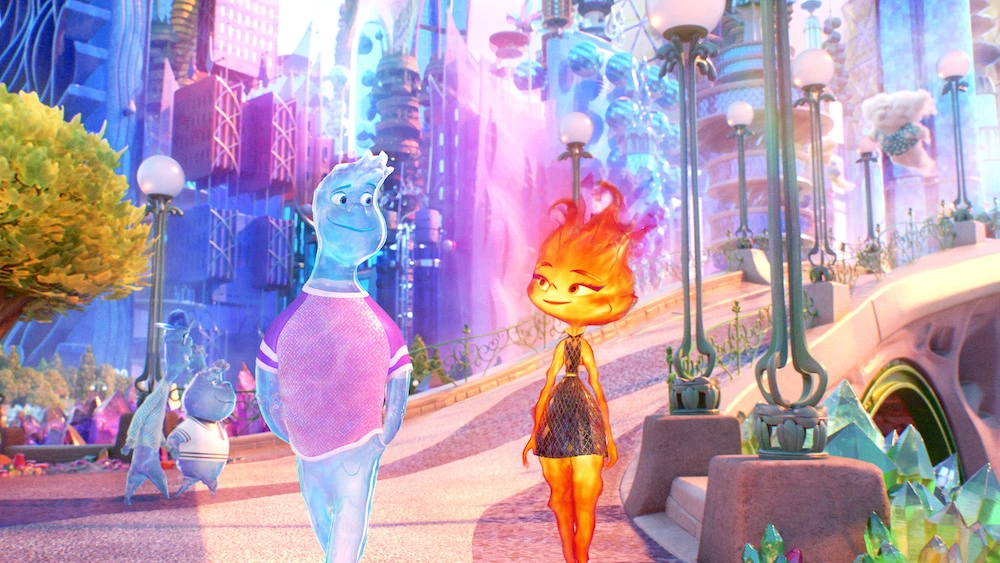
Elemental. Pixar’s Elemental is a movie about an immigrant family struggling to assimilate into a teeming multicultural metropolis while also grappling with its own entrenched prejudices engendered by a history of isolation and alienation. Oh, and its main characters are an anthropomorphized ball of fire and a walking globule of water.
The use of accessible fantasy as a method of conveying high-minded morals to children isn’t novel, but it is somewhat atypical for Pixar. Now 27 pictures into its reign as the preeminent purveyor of American animation, the studio tends to prioritize richly detailed environments and imaginative stories over strenuous didacticism. The messages promoted by Elemental—be open-minded, nurture your children’s dreams, etc.—are noble, but their delivery is oddly clunky, lacking the urgency of Isle of Dogs or the subtlety of Zootopia. Yet even if this new movie is more earnest than inspiring, it’s still a pleasant experience—not just for its characteristically splendorous visuals, but for its appealing detour into a relatively unexplored genre. By which I mean: It’s a romance.
That might seem unremarkable, but it’s even more unusual for Pixar than preachiness; you need to travel back a decade and a half, all the way to the company’s greatest triumph in Wall-E, before you locate a genuine love story. Elemental can’t hope to match that monumental accomplishment, but it’s strangely gratifying to see new-age digital techniques applied in the service of a classical boy-meets-girl narrative.
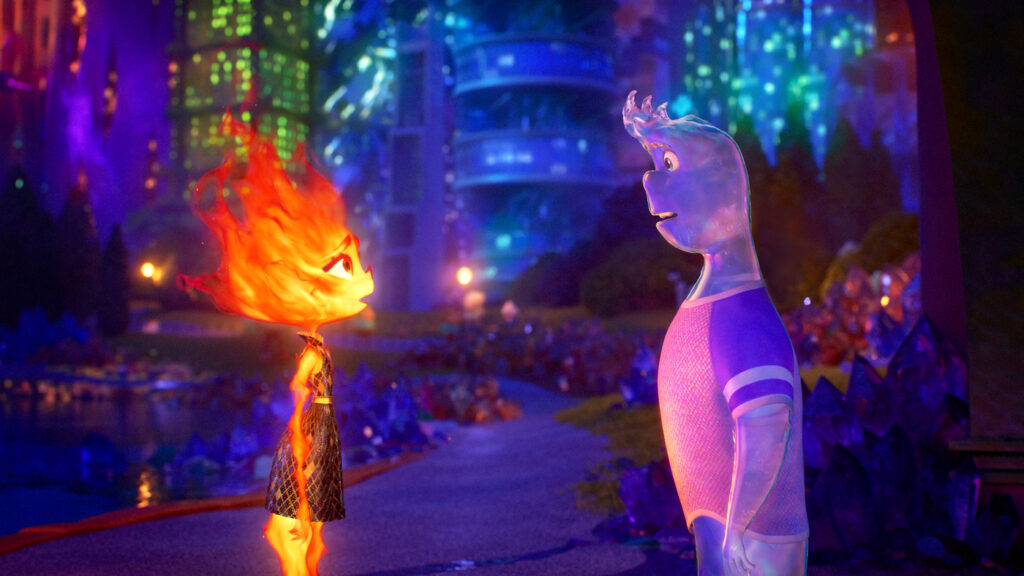
Except this one is more “girl meets boy.” The hero of Elemental—which conceives of a universe where people take the form of one of the four essential earthly substances—is Ember (voiced by Leah Lewis), a member of the fire clan whose parents migrated from their homeland to Element City shortly before her birth. Ember’s father, Bernie (Ronnie del Carmen), runs a specialty shop—the confections for sale include freshly flamed chestnuts and explosive sparklers—which he plans to bequeath to her… just as soon as she gains control of her infamous temper, which tends to interfere with customer relations. Bernie is in some ways an immigrant success story—he and his wife, Cinder (Shila Ommi), have built a thriving business and raised an intelligent first-generation urbanite—but he hasn’t fully embraced his new world order. Living in an enclave called Firetown and speaking in broken English, he betrays a hidebound nature, often muttering about his fire getting “watered down” by a certain species of liquid-based city-dwellers.
Again: not subtle. But Elemental, which was directed by Peter Sohn (The Good Dinosaur), nevertheless develops a whimsical momentum, especially once Ember meets Wade (Mamoudou Athie), an officious inspector—and, of course, a water being—who informs her that he’s compelled to write up citations against her store. Their ensuing interactions aren’t exactly the stuff of high melodrama—the screenplay (by John Hoberg, Kat Likkel, and Brenda Hsueh) resorts to one of those montages that shows them frolicking and growing closer, rather than putting in the labor of detailing their inevitable connection—but there’s still something sweet about their burgeoning affection. The question isn’t just whether fire and water can literally mix; it’s whether the hotheaded Ember and the diffident Wade can enrich one another and make each other happy despite—or perhaps because of—their cultural and temperamental differences.
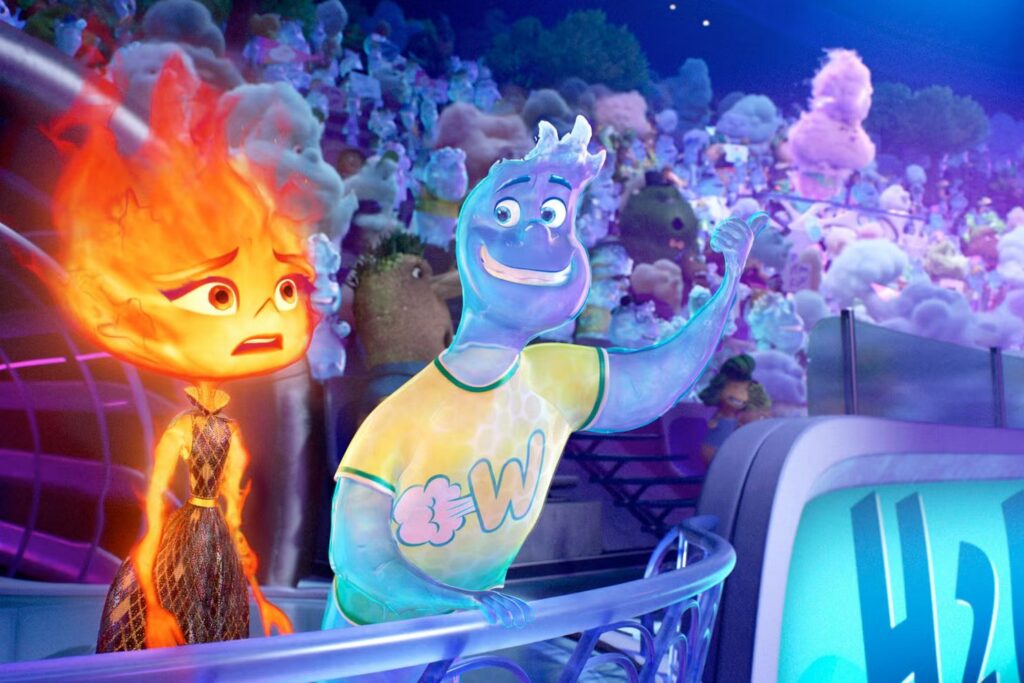
It’s cute. But the real show of Elemental is its aesthetic, which is boisterously vibrant and exquisitely crafted. The fire creatures are a curious thing, with their facial features rendered almost simplistically, as though via charcoal pencil; this crudity contrasts against the vividness of their color and the fluidity of their motion. Speaking of fluid, Wade and his ilk are constructions of marvelous buoyancy, rippling with evocative smoothness. And the achievement extends beyond character design; Element City itself is a hub of whirring, finely detailed activity, while certain sequences—Ember using her artistic skills to turn shards of tempered glass into a gorgeous piece of kaleidoscopic architecture, Wade showing her a luminous underwater flower called a Vivisteria—pulse with the thrill of discovery.
The plot of Elemental—a ticking-clock caper involving broken pipes, inexplicable flooding, and a sacred (and beautiful) blue flame—doesn’t make a whole lot of sense. And a few scenes, such as Wade’s exhortation of a star athlete or Cinder’s battle with a bulky doorman, are either purposeless or dubious. Yet even if the movie qualifies as lesser Pixar—including when compared to the studio’s underrated recent work (Luca, Soul, Turning Red)—it still blends eye-catching animation with thoughtful storytelling. It may not be a fundamental classic, but it’s charming at its core. Grade: B
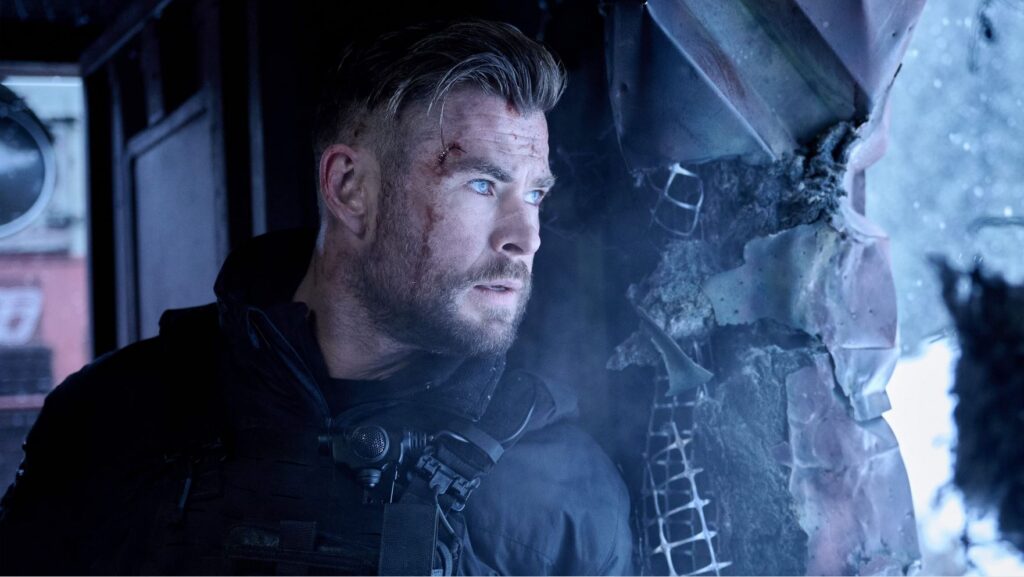
Extraction 2. The first Extraction picture was memorable for exactly one reason: the 12-minute, faux single-take action sequence at its rough midpoint, in which Chris Hemsworth barreled through anonymous foes with deadly precision, the camera racing alongside him as though desperate to bear witness to his lethality. Beyond that, the movie was aggressively unmemorable, with two-dimensional characters, banal themes, and a programmatic plot that may as well have been AI-generated. (In related news, it was written by Joe Russo.) It was the epitome of a Netflix release—easily digestible, utterly forgettable.
Extraction 2 is a more substantial enterprise than its predecessor—not because it alters its formula, but because it executes it with more robust force. In quantitative terms, it only features two good scenes. But given that those scenes make up roughly half its runtime, they can’t be dismissed as fleeting moments; they’re the whole reason the movie exists.
The obvious pièce de résistance of Extraction 2, which was again directed by Sam Hargrave from a “script” by Russo (based on a graphic novel by Ande Parks), is the 21-minute oner that unfolds early on, following some brief and pointless exposition. (Hemsworth’s Tyler is convalescing from his destructive exploits in the first film, he’s questioning his purpose in life, he reluctantly returns to the field because of a family connection, blah blah.) The set piece opens in a Georgian prison, where Tyler must retrieve his sister-in-law (Tinatin Dalakishvili) and her two young children from under the thumb of a vicious gangster (Tornike Bziava). That, naturally, is just the beginning: The camera (operated by Greg Baldi) follows Tyler and his petrified escapees through a maze of underground tunnels, climbs up for a brawl with both guards and convicts in the prison yard, speeds off for a car chase where Tyler and his compatriots—a sister-brother team of handlers, effectively played by Golshifteh Farahani and Adam Bessa—fend off countless pursuers, and finally settles on a speeding train where he wages war against (among other threats) multiple helicopters.
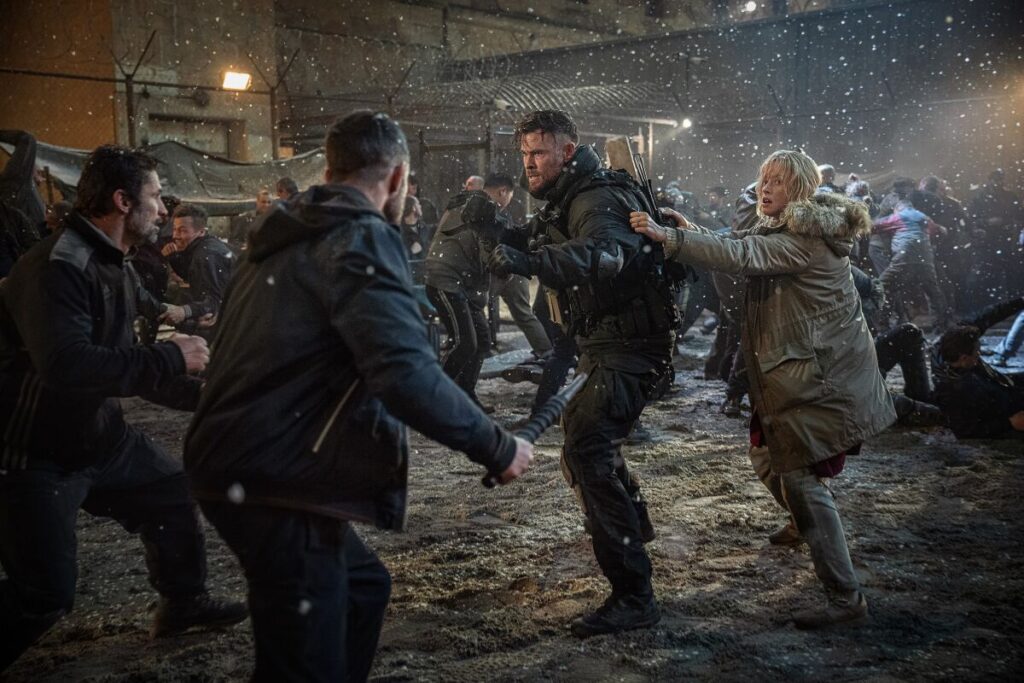
It is difficult to reduce the bravura audacity of this sequence to critical terms. Certainly it is a triumph of cinematography; there are surely invisible cuts along the way, but they’re cleverly concealed, meaning you feel the rush of kineticism while still appreciating the clarity of the choreography. It is also wildly implausible (Tyler’s body count must reach the hundreds), but realism isn’t Hargrave’s objective. His goal is to transmute superhuman exploits to a life-sized scale, and to flaunt his technique in doing so. You might complain that his methods are too showy, but I can’t complain when the results are this breathtaking.
The second major showstopper in Extraction 2—a lengthy assault on a luxury hotel, where Tyler and his crew become hunted rather than hunters—is more conventional but nonetheless exhilarating. There is real care and imagination in its construction, most notably when Tyler and his chief enemy extend their fight onto a glass-roofed mezzanine, flooding their testosterone-fueled duel with a sudden wave of hesitation and caginess. Bits like that are why movies as lazily written as the Extraction films can morph into a franchise.
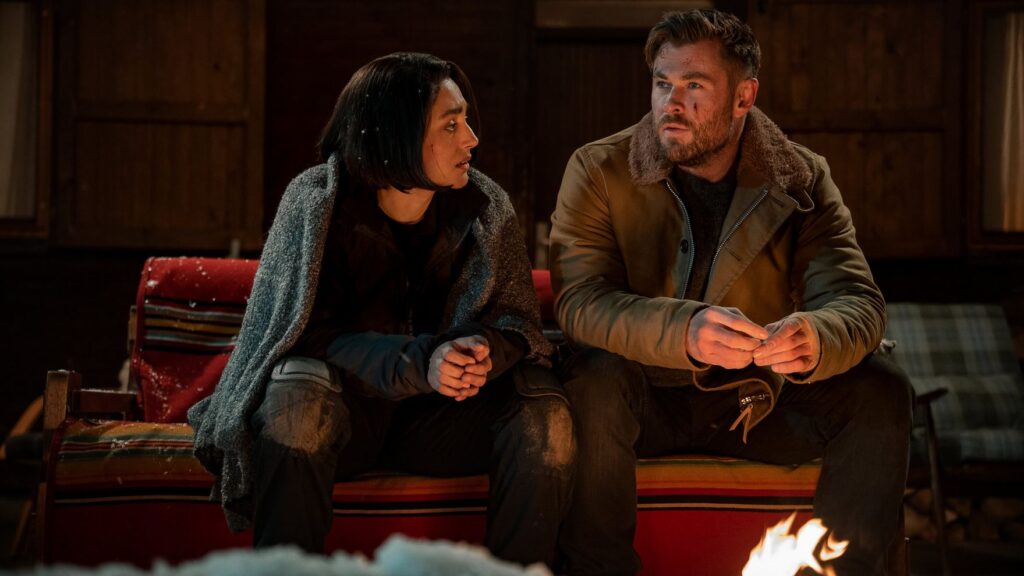
Yet just as I can’t discount the intensity and craft of Extraction 2’s action, I can’t ignore the mundanity that pervades every other aspect of its creation. Tyler is a laughably vague hero, as committed to brooding (he’s assigned a dead kid as motivation) as he is to killing. Hemsworth is an actor of charisma as well as physicality, but unlike his work in the Thor pictures (speaking of which, his intergalactic buddy Idris Elba pops up for a few paycheck-collecting scenes), here he doesn’t get to display his talent for levity; swap him out for any muscled bruiser who can approximate angsty rage, and you wouldn’t lose much gravitas. More perplexing is the glowering big bad (Tornike Gogrichiani), one of those pitiless mobsters with an army of henchmen and a rote thirst for vengeance; he’s very angry and very boring. These movies are so maniacal, they could benefit from an actual megalomaniac—a villain who mangles scenery as well as bodies.
Of course, such playfulness would violate the simmering ethos of the Extraction-verse—that these are gritty films about a gritty man living in gritty times. The solemnity is ironic, because when Extraction 2 succeeds, it’s precisely because of its lack of seriousness; that early oner is utterly outrageous, which is what makes it so great. Hargrave will likely push the envelope even further in the inevitable threequel, but it’d be nice if he challenged himself to do something even more daring: get an actual script to go with the single-take sauce. Grade: B-
Jeremy Beck is the editor-in-chief of MovieManifesto. He watches more movies and television than he probably should.
